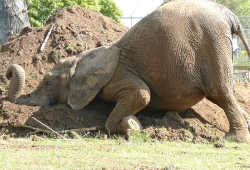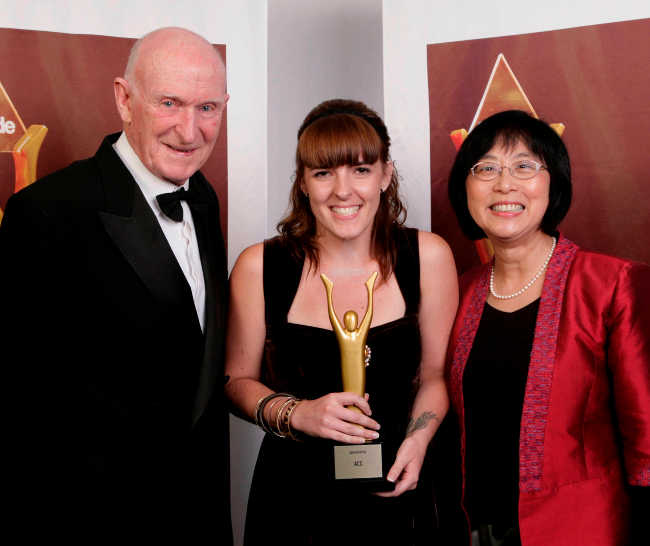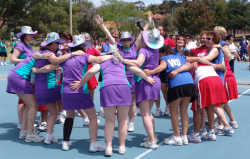Janet Holm – 22/12/99
Abridged with permission from the Canterbury Mountaineer 1995
A love of the mountains was only one facet of the long, rich life of Will Kennedy, but giving others the chance to experience being in the mountains was a keen ambition.
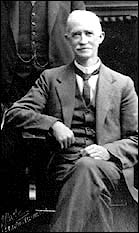 |
| Will Kennedy Photo source: Will’s niece, Frances French-Wright |
Will Kennedy was the right build for a climber: light, clean cut and energetic. So said Huia Beaumont, aged 94, who was a student teacher at Woolston Primary School with Kennedy in 1920. Will took a keen interest in Huia’s tramps around Banks Peninsula and gave him his first pattern for a haversack. Will was always quietly helping someone else to achieve their goal, or giving them a goal to reach. “From him” wrote Andy Anderson, “many an exuberant youth learned that the scaling of peaks or the blazing of new trails was not everything.”
Huia remembers Will as a lovable man. “I have always been grateful for the experience with that class of 105 nine-year-olds and the year with Will Kennedy, the mountaineer, the arranger of picnics to Kennedy’s Bush and the supplier of fortnights of wonderful holidays at his house in Arthur’s Pass.”
Will Kennedy as teacher William Alexander Kennedy (‘Wak’ behind his back) was born on 12 February 1865 at Carleton, an area between Cust and Oxford. His father Hans farmed there, but his daughter Rose saw a better future in teaching for herself and her three brothers, William, John and Hans. At fifteen Will was apprenticed to a school in Christchurch, moving at one stage to Ashburton for two and a half years. In 1890, when he was twenty-five he came to the Woolston Primary School as first assistant, and there he taught standards four and five for the next thirty-three years, retiring in 1923.
He was a much loved teacher according to a former pupil. “He rode a bike to school and a gathering swarm of youngsters joined him, some hanging on, either pushing or pulling, shouting and laughing and sometimes squabbling, till we arrived in state.” An adoring niece who used to help collect the flowers he was given each day by his appreciative pupils said that his class usually numbered about eighty, but he sometimes had up to 107. This wasn’t as chaotic as it sounds. Everyone filed in without talking, greeted the teacher, pulled up benches and took out slates with military precision on the count of 1, 2!
Will took his pupils on walking expeditions all over the Port Hills….. They caught the tram to the Takahe, fought for the honour of carrying Mr Kennedy’s satchel, and then walked along a much lower road to the Sign of the Bellbird where they ate their snacks…. (read more about this walkway).
Never missing out on his passions, Will also taught music and singing, and used the names of lakes, rivers and mountains for his spelling tests…. He introduced his young pupils to passions as diverse as astronomy, chamber music and tobogganing on the snowy slopes of Temple Basin, quietly sharing his infectious enthusiasm and wisdom.
Cycling to the Hermitage at Mt Cook in 1895 There’s little record of Will’s early years, but in 1895 he with his brothers John and Hans and a friend were the first cyclists to reach the Hermitage at Mt Cook. The bulk of their supplies was staggering. “We carried a tent and fly, six single blankets, an oilcloth floor, two billies, a frying pan, a tomahawk, bowls, enamelled cups, plates, etc., a gun and ammunition, maps, a compass, a kit of tools and cycling requisites, a forty-foot flag-rope, a change of clothes, light capes and often four days’ provisions, including ten pounds of flour and the same weight of potatoes …”
They cycled from Temuka to Fairlie where they stocked up with food, celebrating Christmas Day another eight miles on. The next two nights saw them at Irishman’s Creek and Simon’s Pass stations. The road was very rough and at times invisible or deeply rutted; so rough and bumpy after Pukaki that it defied description. They mostly walked, forcing their machines through bogs and long grass, and all four lifting each cycle across never ending streams.
At the Hermitage they had a glorious scramble up the Mueller Glacier to Mount Ollivier on the Sealy Range before they cycled on to Wanaka, Cromwell and Dunedin. Among future cycle trips were expeditions to the North Island and many trips to the Hollyford area with Mr Adams, a fellow teacher at the Woolston School. But that day among the mountains was a turning point for Will Kennedy….
The first private hut at Arthur’s Pass He leased one and a half acres (0.6 of a hectare) of beech forest at Arthur’s Pass from the Crown and during the school holidays of 1911 when the railhead was still at Cass he and fellow teachers built the first private hut at Arthur’s Pass. They had to wear gloves as their fingers stuck to the corrugated iron in the frost. The hut is still there in the bush above Maori Flat, on the east side of Rough Creek. (A local told me that Will ran a line of No. 8 fencing wire around his land to protect his bush from construction workers who cut down the beech trees to use as props for the Otira Tunnel.) For many years, parties of children, student teachers, musicians, climbers, or simply nature-loving friends, were invited to share the joys of his simple retreat. In the sixth standard, Rosa Webb recalled a holiday at Arthur’s Pass with other twelve-year-olds, climbing B’limit and other lesser peaks with Jack Lippe as their friendly guide. There was endless joy for children who could never otherwise have discovered the mountains (read more about the road to the pass today…).
Will’s climbs With no climbing clubs at the time to report activities, there is little record of what Will achieved in the outdoors before 1916, although he made climbing expeditions into the Southern Alps, particularly to the Godley region. He also knew the Hermitage and Hollyford areas…..
In 1920 Will led his final party to the Godley area. Instead of cycling they put their gear and themselves in a hired motor lorry and travelled in majestic splendour. Jack Lippe joined the party in the climb of Mount Dennistoun which they also named. Then Will and Jack Lippe climbed Cumine, McKinnon and Mount Wolseley over the next few days. It is claimed that Mounts Brodrick, Seymour, Francis, Walton and Malthus were other first ascents by Will’s early parties.
Groups of former students visit the hut at the Pass. In 1919 Will met the McLeod family and recognised seventeen-year-old Alison McLeod’s passion for the mountains. “He was very pleased I am so keen on alpine climbing,” she wrote in her diary, “and said ‘I see you are going to be one of the mad ones, too!’ I said, ‘Yes, I think I am going to be very mad.’ ”
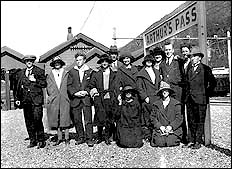 |
| A group of ex-pupils including Rita and Gwen Purdue, their chaperone and their guides, waiting for the train at the old Arthur’s Pass station in the late 1920s Photo source: Lesley Moore, Rita’s daughter Click here for a larger version. |
Alison wrote that every May holidays he took six girls who had left school to his bach at Arthur’s Pass “not for special cleverness but for any good points, as a reward”.
To her delight Alison was asked to join the club that year with five other girls, two chaperones, Jack Lippe the guide, and Jack, Hans and Will Kennedy. The redoubtable Miss Mahalia Mills, the infant mistress at Woolston Primary, is said to have nursed an unrequited passion for Will, so came on most of the expeditions as chaperone and general factotum. She had her own bedroom while the girls slept in bunks in the living room and the young men dossed down in an outbuilding.
They walked everywhere: to Otira, Klondyke corner, to the waterfall on Halpins Creek, the Punchbowl, part of the way up Blimit. Will was much impressed by Alison’s agility. They played and sang around the piano, somehow keeping warm although the water jug in their bedroom was frozen solid…..
Slide collection held by the Canterbury Mountaineering Club Upon his retirement from school work in 1923, Will devoted himself to developing his slide collection, which grew to about 20,000, and was freely available to members of both the Canterbury Mountaineering Club (C.M.C.) and Alpine Clubs throughout New Zealand…..
Jean Lawrence, describing the deserted, rotting railway camp at Arthur’s Pass in 1924 (the tunnel was opened in August 1923), wrote that in those days “Mr Kennedy’s young school teachers were the only other visitors one was likely to meet on the road to the divide or on scrambling up the creeks.”….
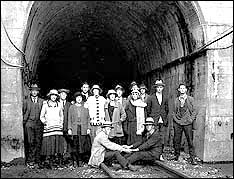 |
| A group of teachers from Addington School at the mouth of the Otira Tunnel Photo source: Album given by pupil teachers to R. B. Clarke, the headmaster of Addington school in 1926 Click here for a larger version. |
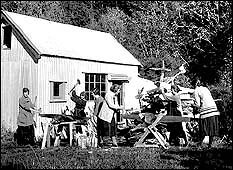 |
| The young women teachers outside the hut doing “men’s work” Photo source: Album given by pupil teachers to R. B. Clarke, the headmaster of Addington school in 1926 Click here for a larger version. |
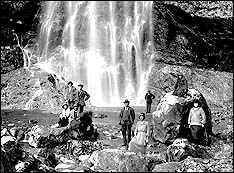 |
| Beside one of the waterfalls in the Park Photo source: Album given by pupil teachers to R. B. Clarke, the headmaster of Addington school in 1926 Click here for a larger version. |
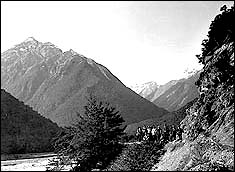 |
| Looking up the Bealey Photo source: Album given by pupil teachers to R. B. Clarke, the headmaster of Addington school in 1926 Click here for a larger version. |
Moves to establish Arthur’s Pass National Park As motor cars and rail travel became more common, there was growing concern at the amount of damage done in the Arthur’s Pass area along roadsides, where plants were taken and shrubs destroyed. Will Kennedy, described by Mac Vincent, a Sun reporter, as “a well-known authority on alpine scenery”, showed lantern slides of the threatened area at a public meeting in the Christchurch City Council Chambers on 3 April 1928.
Soon after a committee was formed, including Kennedy to represent the Christchurch Tramping Club, to submit proposals to the government for an Arthur’s Pass National Park. All through this period Will was holding slide evenings in order to raise money for the first Carrington Hut, which was finally opened in 1929. In 1936, The C. M. C. built a hut at Arthur’s Pass and at Andy Anderson’s insistence it was called the Kennedy Hut (now Kennedy Lodge) in his honour.
Will often lamented in Jack Mitchell’s hearing how little time was left to finish all the jobs he had in hand, and this was so. In May 1939, when Will was seventy four, he gave up the hut at Arthur’s Pass that for nearly thirty years had offered warm hospitality to hundreds of friends of all ages. He retired from the C. M. C. in 1947 on account of his failing health and was then unanimously installed as Patron until his death in 1950. Ill over the last three years of his life and often in great pain, he never complained and still loved to hear the latest climbing exploits…..
After Will’s death on 12 October 1950 Andy Anderson wrote: “It will never be known how many men were inspired to go into the mountains as a result of meeting him and seeing his slides”. Those who came “under the influence of that most lovable man came to look on him as the very personification of what is best in mountaineering.”

